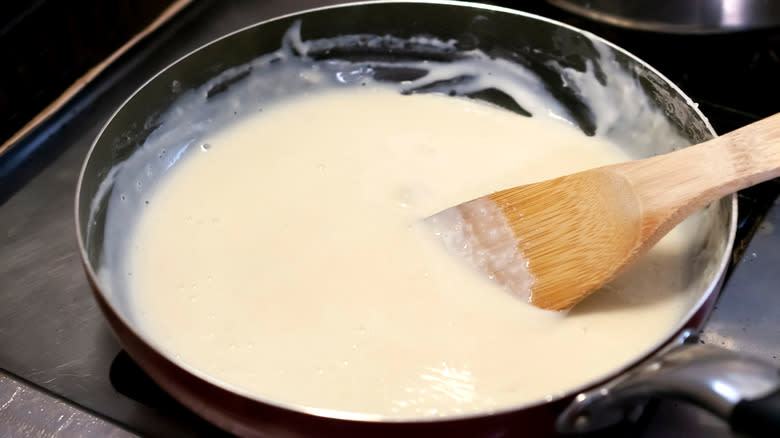Why You Should Cut Butter Into Cubes When Making Béchamel Sauce

In the realm of sauces, few wield as much power as velvety, versatile béchamel. This creamy "mother sauce" forms the cornerstone of countless dishes, from the indulgent macaroni and cheese to the elegant lasagna. At its heart lies the transformation of flour and butter into a roux. Yet, the key to achieving this sauce's ethereal smoothness and flavor lies not only in the precision of this technique, but also in the method by which butter is introduced into the mix.
Mastering this classical French sauce is a fundamental skill for any aspiring chef, at home or in a professional kitchen, so take heed. When adding butter to a hot pan in one hefty lump, the potential for uneven melting and, even worse, burning, significantly increases. The role of the butter is to lubricate the flour particles, facilitating their dispersion and creating a smooth texture. By cutting the butter into cubes before adding it to the roux, a gradual and even melting process is achieved. This gradual incorporation guarantees that the butter disperses uniformly throughout the mixture, avoiding the dreaded burnt notes that could taint the final product. Unlike the slow, sometimes uneven meltdown of a single butter chunk, the cubes melt swiftly. The result is a harmonious amalgamation of flavors and textures, paving the way for a gloriously smooth béchamel sauce.
Read more: 18 Types Of Butter And What Each Is Used For
Bits Of Butter Work In Many Sauces

Béchamel possesses a subtle elegance that serves as a canvas for culinary creativity. Its mellow and delicate nature forms the backbone of dishes that range from simple to sophisticated. To uphold the integrity of this masterpiece, every element involved in its creation must harmonize flawlessly, and this includes the butter. When butter is carelessly integrated into a béchamel sauce, the repercussions can be detrimental. The essence of béchamel is a pristine, milky undertone that complements and enhances the flavors it accompanies; burnt or acrid flavors resulting from uneven melting disrupt the sauce's subtlety, overwhelming its inherent grace.
This principle extends beyond béchamel. Take, for instance, the pan sauce — that glorious reduction of meat juices, aromatics, and wine. When butter is added to the pan, it's introduced in small chunks to ensure a gradual emulsification. Similarly, the revered beurre blanc, a feathery white butter sauce, relies on the gentle incorporation of butter in cold chunks to attain its luxurious texture. In these examples, as with béchamel, butter isn't simply an ingredient; it's an agent of transformation. It has the power to elevate or undermine a dish, depending on how it's introduced. By embracing the technique of cutting butter into cubes, chefs and home cooks alike safeguard the authenticity of their creations.
Read the original article on Tasting Table.

